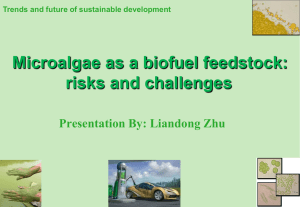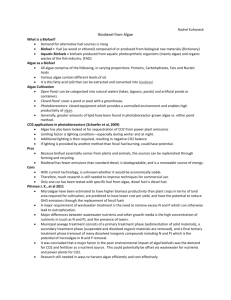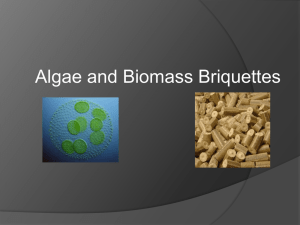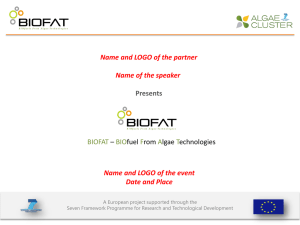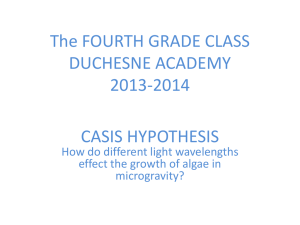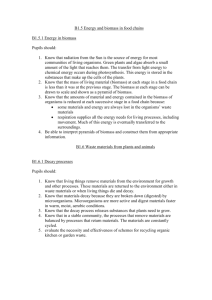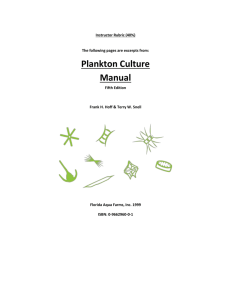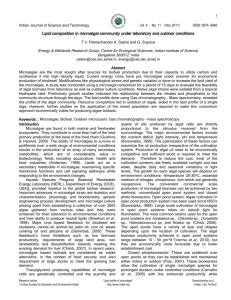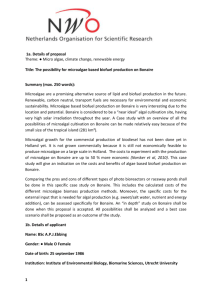Postgraduate Research Opportunity Research opportunity : For MSc
advertisement
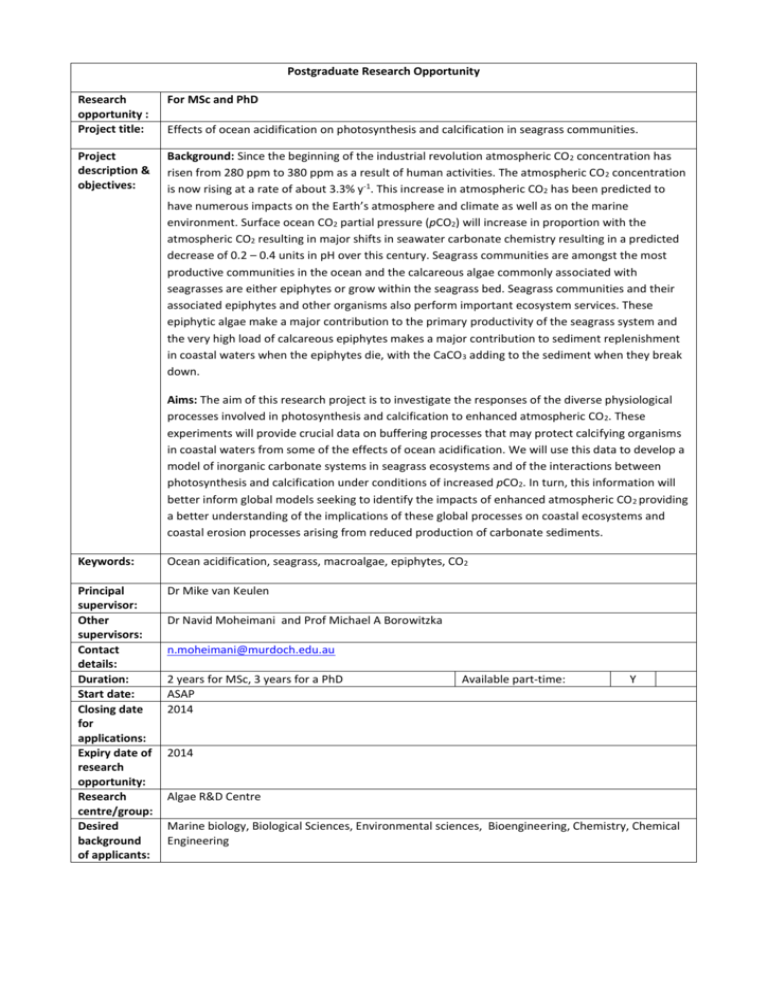
Postgraduate Research Opportunity Research opportunity : Project title: For MSc and PhD Project description & objectives: Background: Since the beginning of the industrial revolution atmospheric CO 2 concentration has risen from 280 ppm to 380 ppm as a result of human activities. The atmospheric CO 2 concentration is now rising at a rate of about 3.3% y-1. This increase in atmospheric CO2 has been predicted to have numerous impacts on the Earth’s atmosphere and climate as well as on the marine environment. Surface ocean CO2 partial pressure (pCO2) will increase in proportion with the atmospheric CO2 resulting in major shifts in seawater carbonate chemistry resulting in a predicted decrease of 0.2 – 0.4 units in pH over this century. Seagrass communities are amongst the most productive communities in the ocean and the calcareous algae commonly associated with seagrasses are either epiphytes or grow within the seagrass bed. Seagrass communities and their associated epiphytes and other organisms also perform important ecosystem services. These epiphytic algae make a major contribution to the primary productivity of the seagrass system and the very high load of calcareous epiphytes makes a major contribution to sediment replenishment in coastal waters when the epiphytes die, with the CaCO 3 adding to the sediment when they break down. Effects of ocean acidification on photosynthesis and calcification in seagrass communities. Aims: The aim of this research project is to investigate the responses of the diverse physiological processes involved in photosynthesis and calcification to enhanced atmospheric CO 2. These experiments will provide crucial data on buffering processes that may protect calcifying organisms in coastal waters from some of the effects of ocean acidification. We will use this data to develop a model of inorganic carbonate systems in seagrass ecosystems and of the interactions between photosynthesis and calcification under conditions of increased pCO2. In turn, this information will better inform global models seeking to identify the impacts of enhanced atmospheric CO 2 providing a better understanding of the implications of these global processes on coastal ecosystems and coastal erosion processes arising from reduced production of carbonate sediments. Keywords: Ocean acidification, seagrass, macroalgae, epiphytes, CO2 Principal supervisor: Other supervisors: Contact details: Duration: Start date: Closing date for applications: Expiry date of research opportunity: Research centre/group: Desired background of applicants: Dr Mike van Keulen Dr Navid Moheimani and Prof Michael A Borowitzka n.moheimani@murdoch.edu.au 2 years for MSc, 3 years for a PhD ASAP 2014 Available part-time: Y 2014 Algae R&D Centre Marine biology, Biological Sciences, Environmental sciences, Bioengineering, Chemistry, Chemical Engineering Postgraduate Research Opportunity Research opportunity : Project title: For MSc and PhD Project description & objectives: This project explores a range of renewable energy production options (i.e. biofuel from algae and electricity) from solar energy. Due to the relatively low solar energy density, relatively large areas are required for renewable energy production. This often comprises either a significant capital outlay, or difficulties in maintaining high use-efficiencies of land, water, nutrients, and other inputs, which increase production costs. The primary contemporary challenge of the renewable energy sector is to reduce economic and non-economic costs by further technological development. Solar energy to electricity and biomass (i.e. microalgae) to bioenergy productions have been studied extensively. However, the co-production of these renewable energies is yet to be tested. This study will examine the potential of co-generation of these renewable energies. Efficient conversion of solar energy to renewable energy Objectives: a. The current advances and challenges of renewable technologies and feedstocks, and their relationship to non-renewable and renewable inputs. b. Develop a novel methodology for efficient conversion of solar energy to renewable energy c. Test the method under laboratory conditions d. Test the method under outdoor conditions. e. Assessing the economics and life cycle analysis Keywords: Biofuel, Bioenergy, Biomass, renewable energy, electricity, microalgae, macro algae, solar panels Principal supervisor: Other supervisors: Contact details: Duration: Start date: Closing date for applications: Expiry date of research opportunity: Research centre/group: Desired background of applicants: Dr Navid Moheimani Prof Michael A Borowitzka, Dr David Parlevliet n.moheimani@murdoch.edu.au 2 years for MSc, 3 years for a PhD ASAP 2014 Available part-time: Y 2014 Algae R&D Centre Bioengineering, Biological Sciences, Environmental sciences, Chemistry, Chemical Engineering Postgraduate Research Opportunity Research opportunity : Project title: For MSc and PhD Project description & objectives: Global warming, climatic changes and even more importantly current energy crisis (i.e. oil peak) call for technological and commercial advances in producing high standard transportation fuels. Considering that almost all conventional current biofuel feedstocks (such as sugar cane, canola oil, tallow, palm oil) are not economical and more importantly not environmentally sustainable due to pressure on food and animal supplies and agricultural land uses, there is an urgent need to find alternative non food based biomass feedstocks. Microalgae are one of the most promising candidates for replacing current biofuel feedstocks. On the other hand for any successful commercial large-scale culture, the culture must be reliable, stable and be able to be highly productive for long periods with minimum management requirements. The maximum theoretical photosynthetic efficiency is 12%. However, due to various limits to the growth of the algae, to date, no outdoor algae culture has achieved a photosynthetic efficiency of greater than 4%. This study will focus on identifying these limits to the growth of microalgae outdoor cultivation and how they might be reduced. The interaction between these limits to the growth will also be tested under indoor and outdoor conditions. Keywords: Biofuel, Bioenergy, Biomass, renewable energy, microalgae, algae culture Principal supervisor: Other supervisors: Contact details: Duration: Start date: Closing date for applications: Expiry date of research opportunity: Research centre/group: Desired background of applicants: Dr Navid Moheimani Limits to growth to the growth of microalgae in large-scale culture systems Prof Michael A Borowitzka n.moheimani@murdoch.edu.au 2 years for MSc, 3 years for a PhD ASAP 2014 Available part-time: Y 2014 Algae R&D Centre Biological Sciences, Environmental sciences, Bioengineering, Chemistry, Chemical Engineering Postgraduate Research Opportunity Research opportunity : Project title: For MSc and PhD Project description & objectives: Background: The production of renewable transport fuels from crops such as oilseeds has economic as well as ethical problems, largely because of the potential competition for limited resources with food crops. The use of microalgae offers an attractive alternative as algae production does not necessarily compete for fresh water (e.g. marine algae) or arable land. Furthermore, microalgae photosynthetic rates are about 10 times higher on an areal basis than terrestrial photosynthesis and this offers an accordingly smaller footprint of the operation, provided a suitable climate and sunshine hours are available (e.g. WA). Non-destructive oil extraction from microalgae In general, existing operations and published work on microalgae production aims at growing the biomass of the algae (requiring large quantities of fertilisers) followed by harvesting algal cells, dewatering, extracting of lipids, transesterification if needed (for biodiesel). Only about 30% of the dry biomass can be extracted as a lipid resulting in a significant continuous amount of waste algal biomass as a by-product. The treatment and disposal of this significant waste further limits the potential profits gained from the overall operation. The key reason why the production of biofuels from microalgae has not been yet succeeded as a source of sustainable transport fuel is the costs involved and indeed the amount of energy needed for the complete operation compared to the energy obtained as the final fuel. A large component of the energy costs are the extraction of the oil, disposal of biomass and energy value of the nutrient fertiliser needed for re-growing the algae. Some of these costs can be offset by carefully integrated systems, and is the subject of a Commonwealth funded project currently underway by our group at Murdoch University and University of Adelaide. Objectives: This current proposal suggests a compelling and radically different approach towards cutting energy and fertilizer costs in the production of biofuels from microalgae: Rather than growing the algae in the presence of fertilisers (here nutrients such as N and P) followed by harvesting the whole algal cells and the energetically costly drying of cells and separation of the fuel from the cells this process intends to make use from the natural tendency of the green alga, Botryococcus braunii to produce and release oils from the cell during and after growth. Botryococcus sp. generates >50% of its cell dry-weight as a hydrocarbon (compared to about 30% in other species). This concept of harvesting the pure oil released while recycling rather than discarding the bio-catalytic algae cells is similar to “milking”. Traditional algae production systems kill the cow (algae) to extract the milk rather than re-using the cow for many batches of milk. The reason why the use of hydrocarbon releasing Botryococcus sp. has not been commercially exploited is the well established slow growth of this alga. However by developing a non destructive (milking) strategy, the alga does not need to be grown repeatedly for each extraction but can be reused and in fact does not have to grow at all as long as the fuel can be harvested without killing the algal cells (cows don’t need to grow for producing milk). By not re-growing Botryococcus sp after each extraction, there are significant savings in fertiliser (nutrients) usage and waste biomass disposal costs. Similarly, other algae can be maintained in a non-growing state where they produce significantly more lipids and do not require expensive nutrients, while some of produced lipid is harvested by ‘milking’. Keywords: Biofuel, Bioenergy, Biomass, renewable energy, microalgae, Botryococcus braunii Principal supervisor: Dr Navid Moheimani Other supervisors: Contact details: Duration: Start date: Closing date for applications: Expiry date of research opportunity: Research centre/group: Desired background of applicants: Prof Michael A Borowitzka, Dr Ralf Cord-Ruwisch n.moheimani@murdoch.edu.au 2 years for MSc, 3 years for a PhD ASAP 2014 Available part-time: Y 2014 Algae R&D Centre Biological Sciences, Environmental sciences, Bioengineering, Chemistry, Chemical Engineering
